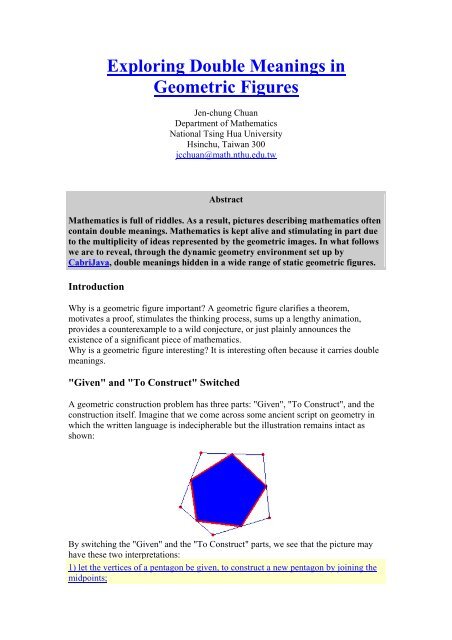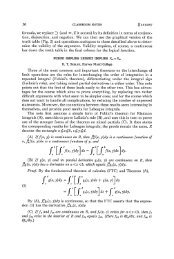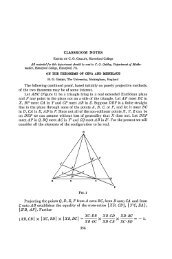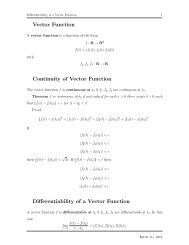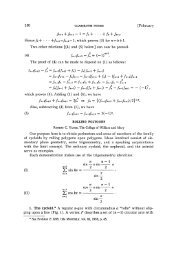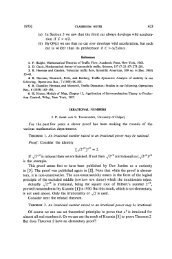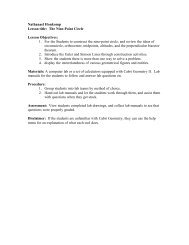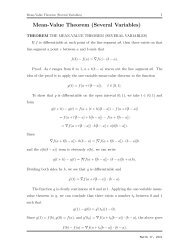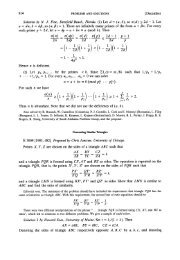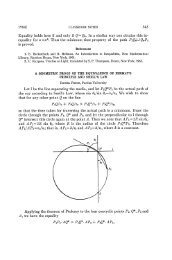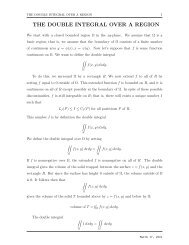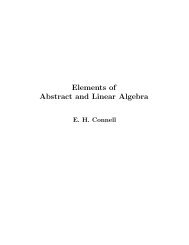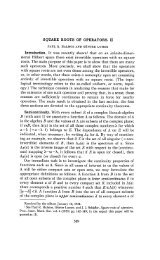Exploring Double Meanings in Geometric Figures
Exploring Double Meanings in Geometric Figures
Exploring Double Meanings in Geometric Figures
Create successful ePaper yourself
Turn your PDF publications into a flip-book with our unique Google optimized e-Paper software.
<strong>Explor<strong>in</strong>g</strong> <strong>Double</strong> <strong>Mean<strong>in</strong>gs</strong> <strong>in</strong><br />
<strong>Geometric</strong> <strong>Figures</strong><br />
Jen-chung Chuan<br />
Department of Mathematics<br />
National Ts<strong>in</strong>g Hua University<br />
Hs<strong>in</strong>chu, Taiwan 300<br />
jcchuan@math.nthu.edu.tw<br />
Abstract<br />
Mathematics is full of riddles. As a result, pictures describ<strong>in</strong>g mathematics often<br />
conta<strong>in</strong> double mean<strong>in</strong>gs. Mathematics is kept alive and stimulat<strong>in</strong>g <strong>in</strong> part due<br />
to the multiplicity of ideas represented by the geometric images. In what follows<br />
we are to reveal, through the dynamic geometry environment set up by<br />
CabriJava, double mean<strong>in</strong>gs hidden <strong>in</strong> a wide range of static geometric figures.<br />
Introduction<br />
Why is a geometric figure important? A geometric figure clarifies a theorem,<br />
motivates a proof, stimulates the th<strong>in</strong>k<strong>in</strong>g process, sums up a lengthy animation,<br />
provides a counterexample to a wild conjecture, or just pla<strong>in</strong>ly announces the<br />
existence of a significant piece of mathematics.<br />
Why is a geometric figure <strong>in</strong>terest<strong>in</strong>g? It is <strong>in</strong>terest<strong>in</strong>g often because it carries double<br />
mean<strong>in</strong>gs.<br />
"Given" and "To Construct" Switched<br />
A geometric construction problem has three parts: "Given", "To Construct", and the<br />
construction itself. Imag<strong>in</strong>e that we come across some ancient script on geometry <strong>in</strong><br />
which the written language is <strong>in</strong>decipherable but the illustration rema<strong>in</strong>s <strong>in</strong>tact as<br />
shown:<br />
By switch<strong>in</strong>g the "Given" and the "To Construct" parts, we see that the picture may<br />
have these two <strong>in</strong>terpretations:<br />
1) let the vertices of a pentagon be given, to construct a new pentagon by jo<strong>in</strong><strong>in</strong>g the<br />
midpo<strong>in</strong>ts;
2) given a pentagon, to construct another one whose midpo<strong>in</strong>ts co<strong>in</strong>cide with the<br />
corners of the given ones.<br />
This t<strong>in</strong>y example shows that dynamic geometry is at least twice as <strong>in</strong>terest<strong>in</strong>g as the<br />
traditional one.<br />
In the same ve<strong>in</strong>, consider the figure illustrat<strong>in</strong>g the Pascal theorem:<br />
The picture carries two messages:<br />
1) if a hexagon is <strong>in</strong>scribed <strong>in</strong> a conic, then the three pairs of opposite sides meet <strong>in</strong><br />
coll<strong>in</strong>ear po<strong>in</strong>ts;<br />
2) there is a conic pass<strong>in</strong>g through five given po<strong>in</strong>ts; the illustration shows how to<br />
construct all others po<strong>in</strong>ts of the curve.<br />
Evolute and Involute<br />
Involute is the path of a po<strong>in</strong>t of a str<strong>in</strong>g tautly unwound from the curve. Evolute of a<br />
curve is the locus of its center of curvature. Here is a figure consist<strong>in</strong>g of l<strong>in</strong>e<br />
segments each jo<strong>in</strong><strong>in</strong>g a po<strong>in</strong>t of a cardioid with its center of curvature:<br />
The figure may be <strong>in</strong>terpreted <strong>in</strong> two ways:<br />
1) the figure consists of normal l<strong>in</strong>es to the outer cardioid hav<strong>in</strong>g the length the radius<br />
of curvature; consequently an envelope (its evolute) appears <strong>in</strong> the form of the <strong>in</strong>ner
cardioid;<br />
2) the region <strong>in</strong>dicates where a str<strong>in</strong>g tautly unwound from the <strong>in</strong>ner cardioid has<br />
swept, the endpo<strong>in</strong>t sweep<strong>in</strong>g out the outer cardioid.<br />
The same phenomenon exists <strong>in</strong> other epicycloids and hypocycloids as well:<br />
S<strong>in</strong>ce the epicycloid and its <strong>in</strong>volute can be transformed <strong>in</strong>to one another by a central<br />
similarity, an <strong>in</strong>terest<strong>in</strong>g nested pattern may be constructed after this method:<br />
Cardioid and Perpendicular Tangents<br />
Here is a static figure show<strong>in</strong>g two perpendicular tangent l<strong>in</strong>es of the cardioid:<br />
There are two ways to regard the figure as a particular <strong>in</strong>stance of a sequence of shots:
1) the cardioid rema<strong>in</strong>s stationary while the pair of orthogonal tangents travel<strong>in</strong>g<br />
around the curve;<br />
2) the cardioid slides along two fixed orthogonal straight l<strong>in</strong>es.<br />
The similar phenomenon exists <strong>in</strong> other epicycloids and hypocycloids as well:<br />
Peaucellier Cell<br />
The design of the l<strong>in</strong>kage known as the Peaucellier cell was the first mechanical<br />
<strong>in</strong>versor ever awarded:<br />
The device may be used <strong>in</strong> two ways:<br />
1) it transforms the l<strong>in</strong>ear motion <strong>in</strong>to a circular one;<br />
2) it transforms the circular motion <strong>in</strong>to a l<strong>in</strong>ear one.<br />
Evelyn Sander has a webpage devoted to the discussion of Peaucellier's cell.<br />
Construction with Ruler Only<br />
Stimulated by the theory of perspective, the study of the constructive power of a ruler<br />
was carried out <strong>in</strong> full dur<strong>in</strong>g the 19th century. <strong>Geometric</strong> figures so constructed<br />
usually consist of straight l<strong>in</strong>es only. Such figures can be borrowed to create amus<strong>in</strong>g<br />
puzzles by ask<strong>in</strong>g: what was the process of construction? Thus, for example, if we<br />
regard this figure as the solution,
what then, is the question? There are two possibilities:<br />
1) given the midpo<strong>in</strong>t of a l<strong>in</strong>e segment and given another po<strong>in</strong>t not on the segment, to<br />
construct, us<strong>in</strong>g the ruler alone, a straight l<strong>in</strong>e pass<strong>in</strong>g through the given po<strong>in</strong>t and<br />
parallel to the given l<strong>in</strong>e segment;<br />
2) given a l<strong>in</strong>e parallel to a l<strong>in</strong>e segment, to construct, us<strong>in</strong>g the ruler alone, the<br />
midpo<strong>in</strong>t of the l<strong>in</strong>e segment.<br />
Here is a book devoted to constructions of this sort:<br />
A. S. Smogorzhevskii, The Ruler <strong>in</strong> <strong>Geometric</strong>al Construction.<br />
For those who are curious, there is another book translated from Russian on the<br />
subject of geometric constructions with the compasses alone:<br />
Aleksandr Kostovskii, <strong>Geometric</strong> Constructions with Compasses Only<br />
Ellipse and Deltoid<br />
This picture does not appear impressive until turned <strong>in</strong>to a dynamic one:<br />
Depend<strong>in</strong>g how the "camera" is manipulated, we may build these two sequences of<br />
animation:<br />
1) the ellipse is shown to be rotate around rigidly while rema<strong>in</strong> tangent to the deltoid<br />
<strong>in</strong>ternally;<br />
2) the deltoid is to rotate around while touch<strong>in</strong>g the fixed ellipse all the time.<br />
Coaxal Systems
Can you make circles <strong>in</strong> this illustration of the coaxal system move?<br />
Based on two different pr<strong>in</strong>ciples of design, the static picture can be turned <strong>in</strong>to a<br />
dynamic one with<br />
1) all circles seem to march <strong>in</strong> one direction only;<br />
2) one half of the circles march towards left while the other half towards right.<br />
Deltoid and Three-Cusped Epicycloid<br />
This figure conveys two messages:<br />
1) between the deltoid and the 3-cusped epicycloid there are circles hav<strong>in</strong>g center on<br />
the base circle and tangent to both;<br />
2) there is a family of circles envelop<strong>in</strong>g both the deltoid and the 3-cusped epicycloid.<br />
Similar situations take place for the astroid and the 4-cusped epicycloid pair also:
Euclidean and Non-Euclidean Geometries<br />
Consider this <strong>in</strong>terest<strong>in</strong>g figure:<br />
The figure can be regarded as either an illustration of a theorem <strong>in</strong> Euclidean<br />
geometry, or an illustration of a theorem <strong>in</strong> Non-Euclidean geometry.<br />
1) as a figure <strong>in</strong> the Euclidean geometry, it shows the three arcs each orthogonal to the<br />
big circle and pass<strong>in</strong>g through the po<strong>in</strong>ts of <strong>in</strong>tersection of two circles, meet at one<br />
po<strong>in</strong>t;<br />
2) as a figure under the Po<strong>in</strong>care model of the Non-Euclidean geometry it shows the<br />
three common chords of pairs of circles meet are concurrent. This is the Non-<br />
Euclidean version of this illustration <strong>in</strong> Euclidean geometry:
2D Phenomena Expla<strong>in</strong>ed Through 3D<br />
There are <strong>in</strong>terest<strong>in</strong>g theorems who proofs can be given when the 2D figures so drawn<br />
be viewed as 3D figures. One such famous results is Monge Theorem:<br />
Here are the statements of the orig<strong>in</strong>al theorem and its three-dimensional counterpart:<br />
1) the common external tangents to each pair of three different-sized circles meet <strong>in</strong><br />
three coll<strong>in</strong>ear po<strong>in</strong>ts;<br />
2) the envelop<strong>in</strong>g tangent cones of each pair of three different-sized spheres have<br />
coll<strong>in</strong>ear vertices.<br />
You may consult Ogilvy's charm<strong>in</strong>g book "Excursions <strong>in</strong> Geometry" pp. 115-117 to<br />
see the complete explanation.<br />
Here is another theorem belong<strong>in</strong>g to the same category, known as Desargues' Two-<br />
Triangle Theorem:
Depend<strong>in</strong>g on the 2D or the 3D po<strong>in</strong>t of view, the figure says:<br />
1) copolar triangles are coaxial, and conversely;<br />
2) copolar triangles <strong>in</strong> space are coaxial, and conversely.<br />
This is just one of the four different proofs of Desargues' Two-Triangle Theorem<br />
given <strong>in</strong> Howard Eves' masterpiece "A Survey of Geometry".<br />
<strong>Double</strong> Generation<br />
Question: which of the follow<strong>in</strong>g two statements is correct?<br />
1) the deltoid is the locus of a po<strong>in</strong>t on the circumference of a circle which rolls round<br />
the <strong>in</strong>side of a fixed circle triple the radius;<br />
2) the deltoid is the locus of a po<strong>in</strong>t on the circumference of a circle which rolls round<br />
the <strong>in</strong>side of a fixed circle 3/2 the radius.<br />
Answer: Both are correct!<br />
With the traditional pr<strong>in</strong>t<strong>in</strong>g technology this is all that can be illustrated:<br />
Under the dynamic geometry environment it is highly stimulat<strong>in</strong>g to construct the<br />
phenomenon known as the "double generation" which states that every cycloidal<br />
curve may be generated <strong>in</strong> two ways: by two roll<strong>in</strong>g circles the sum, or difference, of<br />
whose radii is the radius of the fixed circle.<br />
Ste<strong>in</strong>er Porism, Poncelet Porism<br />
Accord<strong>in</strong>g to the Webster's 1828 dictionary, a porism is def<strong>in</strong>ed this way:
"a proposition affirm<strong>in</strong>g the possibility of f<strong>in</strong>d<strong>in</strong>g<br />
such conditions as will render a certa<strong>in</strong> problem<br />
<strong>in</strong>determ<strong>in</strong>ate or capable of <strong>in</strong>numerable<br />
solutions." It is not a theorem, nor a problem, or<br />
rather it <strong>in</strong>cludes both.<br />
So much for an attempt to def<strong>in</strong>e a respectable mathematical result! One th<strong>in</strong>g is clear:<br />
any statement qualified to be named a "porism" must have double mean<strong>in</strong>gs.<br />
This illustration of the Ste<strong>in</strong>er porism<br />
carries double mean<strong>in</strong>gs as follows:<br />
1) If two circles admit a Ste<strong>in</strong>er cha<strong>in</strong>, they admit an <strong>in</strong>f<strong>in</strong>ite number, and any one of<br />
the direct tangent circles is a member of one cha<strong>in</strong>;<br />
2) under the Po<strong>in</strong>caré's model of non-Euclidean geometry, if two circles are so<br />
related that a polygon can be <strong>in</strong>scribed to one and circumscribed to the other, then<br />
<strong>in</strong>f<strong>in</strong>itely many polygons can be so drawn.<br />
Statement 1) is known as the Ste<strong>in</strong>er's porism, while statement 2) is known as the<br />
Poncelet's porism.
Front and Back<br />
When the graph of the plane graph of the function y = s<strong>in</strong> 2x were wrapped around a<br />
cyl<strong>in</strong>der, it appears as:<br />
The reason a primitive draw<strong>in</strong>g such as this appears as a three-dimensional object is<br />
because <strong>in</strong> our m<strong>in</strong>d we have assigned the notion "front" and "back" to the crucial<br />
portions of the figure. But then, there are two such possibilities!<br />
References<br />
1. H. S. M. Coxeter, Introduction to Geometry<br />
2. He<strong>in</strong>rich Dorrie, 100 Great Problems of Elementary Mathematics<br />
3. Howard Eves, A Survey of Geometry<br />
4. Roger A. Johnson, Advanced Euclidean Geometry<br />
5. A.B. Kempe, How to draw a straight l<strong>in</strong>e; a lecture on l<strong>in</strong>kage, repr<strong>in</strong>ted by<br />
Chelsea <strong>in</strong> the collection "Squar<strong>in</strong>g the Circle"<br />
6. Aleksandr Kostovskii, <strong>Geometric</strong> Constructions with Compasses Only<br />
7. E. H. Lockwood, A Book of Curves<br />
8. A. S. Smogorzhevskii, The Ruler <strong>in</strong> <strong>Geometric</strong>al Construction<br />
9. David Wells, Hidden Connections, <strong>Double</strong> <strong>Mean<strong>in</strong>gs</strong><br />
10. Robert C. Yates, A Handbook on Curves and Their Properties<br />
11. Robert C. Yates, <strong>Geometric</strong>al Tools, a mathematical sketch and model book


